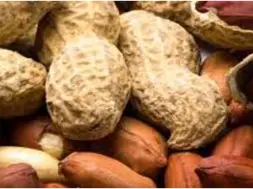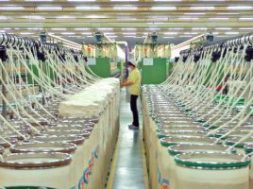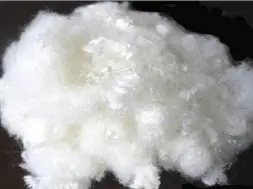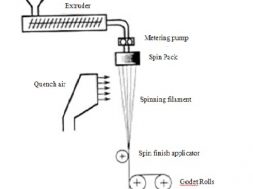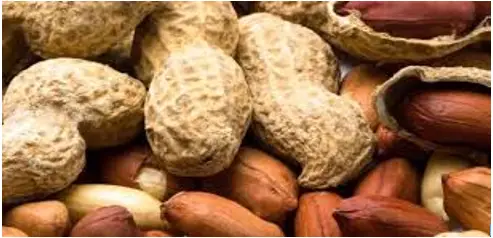
Groundnut Fibre
Groundnut Fibres | Chemical Structure of Groundnut Fibre | Production of Groundnut Fiber
One of the most likely sources of vegetable protein for fiber production was groundnuts, which grow as a staple product in many of the hot, humid regions of the world.
Groundnuts (peanuts, monkey nuts) are used in large quantities as a source of the arachis oil required for making margarine. The meal remaining after removal of the oil contains a high proportion of protein. This protein was regarded as a potentially suitable source of vegetable protein. The nuts contain around 25 % protein and can be good and can be good and cheap resources for protein fiber.

Chemical Structure of Groundnut fiber
Groundnut fiber is having a circular cross-section and smooth, slightly striated surface. It is having tensile strength of 8-12 kg/mm2 (11,000-14,000 ib/in2). It does not soften or melt on heating. It chars at 250 deg c. It is degraded by sodium hypochlorite and sodium chlorite bleaches. Good resistance to organic solvents. Maybe dry cleaned without difficulty.
Groundnut protein fibers are generally similar to wool in that they are protein in structure. They do not have the rough scaly surface of wool fibers and do not undergo felting in the way that wool does.
Groundnut protein molecules carry many side chains, and they cannot pack so closely together as the molecules of silk. Groundnut protein yields a relatively weak fiber, which is much more sensitive to moisture than wool.
Production of groundnut fiber:
Groundnuts are cultivated in India, China, West Africa, and southern states of U.S.A. After harvesting, the nuts are shelled or decorticated. The red skins are removed from the shelled nuts, together with foreign matter such as small stones and nails.
There are 5 main steps to produce Groundnut fiber.
Flow chart given below :
Extraction of oil to obtain oil-free meal
Extraction of protein
Preparation of spinning solution
Fiber formation
After treatments
1 . Extraction of oil to obtain oil-free meal:
The nuts, which contain about 50 % of oil, are crushed and pressed by machine. About 80% of the available oil is squeezed out, leaving the oily groundnut meal which is reduced in breaker rolls and passed through flaking rolls. The thin flakes pass via a series of buckets on an endless chain into an extraction plant. As they pass through the plant, the buckets of the meal are subjected to a thorough washing with a solvent (Hexane) which removes the remainder of the Arachis oil.
2 . Extraction of protein:
The extracted meal is heated under low pressure in steam jacketed pans to remove residual solvent. It is then cooled, screened, weighed and bagged.
This special technique for removing oil from groundnut meal was devised to provide protein suitable for fiber production. The groundnut protein is extracted from the meal by dissolving it in caustic soda solution. The residue after extraction is a valuable cattle food. Then acidification of the protein solution precipitates the protein, which is the raw material from which fiber is spun.
3 . Preparation of spinning solution:
The spinning solution is prepared by dissolving the extracted protein in aqueous urea, ammonia, caustic soda and solutions of detergents. Caustic soda is used for dissolution. It is allowed to mature under controlled condition for 24 hours. During the maturation, the viscosity of the solution increases and attains the spinning characteristics. The solids content of the protein is between 12 -30 %.
4 . Fiber formation:
Groundnut fiber is formed by the wet spinning method. The solution of groundnut protein is filtered and pumped to spinnerets, through which it is extruded at a constant rate into an acid coagulating bath. The spinneret holes are typical of 0.07 – 0.10 mm diameter.
The coagulating liquor consists of a solution containing sulphuric acid, sodium sulfate, and auxiliary substances. It is maintained at a temperature between 12-40 deg c.
5 . After treatments:
As the filament is being spun, it is stretched to increase the alignment of the protein molecule. It coagulates to a filament that is weak and flabby when wet and brittle when dry. At this stage, the filament dissolves easily in dilute saline solution and in dilute acid and alkali. After leaving the coagulating bath it is treated with formaldehyde to harden and insolubilize it, and it is then dried and cut into staple fiber.
Uses of groundnut protein fiber (GPF):
In the 1950s ardil fiber (groundnut protein fiber) was intensively marketed for industrial and domestic uses. Dresses, suits and pajamas were promoted with the slogan ‘Happy families wear clothes that contain Ardil’.
- Ardil fibers were used as garments, carpets or upholstery.
- Ardil/Wool blends were used for sweaters, blankets, underwear, carpets and felt.
- Blends with cotton were used for sports shirts, pajamas, dress fabrics
- Blends with rayon for costume and dress fabrics, tropical clothing, sports shirts, and carpets.
- In course of time, these fibers were subsequently overshadowed by the successful synthetic fibers such as nylon and have been largely forgotten.
However, presently more eco-friendly and biodegradable material has been given importance and so the manufacture of these fibers again getting momentum. Groundnut fiber is more commercialized now and it is expected that others will also follow.
Areas and Trade Names:
In Pakistan Gujarat is the largest producing state accounting for 40% of total groundnut produced in the country. While internationally China is the largest producer.
Groundnuts are cultivated in India, China, West Africa, and southern states of U.S.A. After harvesting, the nuts are shelled or decorticated.
Europe is a large market for groundnuts, with an estimated average consumption of 650 thousand tons per year. Imports show a growing market, with an average annual increase of 2% in volume and 3.9% in value from 2013 to 2017. Groundnuts are consumed as snacks, processed as food ingredients and crushed for oil. This study focuses on groundnuts for the European food manufacturing and oil crushing industries.
References:
- https://textilevaluechain.in/2017/06/15/clothing-from-ground-nut-fibres-2/#:~:text=Groundnut%20fibre%20is%20formed%20by,of%200.07%20%E2%80%93%200.10%20mm%20diameter
- https://www.textiletoday.com.bd/groundnut-protein-fiber-properties-end-use
(121)
